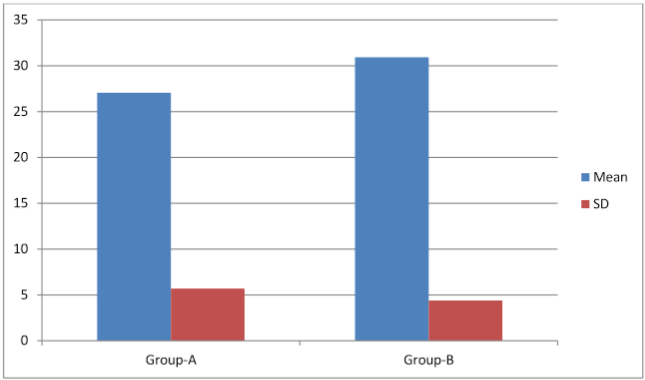Effectiveness of Proprioceptive Neuromuscular Facilitation V/S Massage in Patients with Bell’s Palsy.
Main Article Content
Abstract
Bell’s palsy has a set of treatment protocol including traditional techniques e.g. massage, MMT, PNF, etc. as well as advanced modalities such as electrical stimulation. As we know massage and PNF both are traditional therapeutic techniques to treat Bell’s palsy and used worldwide. The techniques are mainly focused on the qualitative recovery of the facial muscles as the primary recovery is achieved by electrical stimulation. Due to lack of time and resources the therapists tend to use only one of them. Thus this study will be done to find out which one of them is more effective and will ensure more qualitative recovery in minimum amount of time.Unilateral Bell’s palsy patients were taken and filtered according to inclusion and exclusion criteria. Total 30 patients were included and divided into 2 groups (Group A and Group B). Every patient was assessed according to Sunnybrook Facial Grading Scale and the readings were recorded. Treatment protocol for group A was PNF along-with stimulation and for group B massage along-with stimulation. After 2 weeks of standard treatment protocol again assessment was taken using Sunnybrook Facial Grading Scale and the readings were recorded. With the pre and post-treatment readings difference was calculated for both groups and statistical analysis was done.PNF is considered slightly significant as a result of comparing the readings of Sunnybrook Facial Grading System between both the groups immediately after the intervention.It can be concluded that the PNF is significantly effective than massage. But, massage also has remarkable recovery. Therefore it is advisable to use both of them for good recovery.
Article Details
References
Bell’s palsy: aetiology, clinical features and multi-disciplinary care. Timothy Eviston, Glen Croxson, Peter Kennedy, Tessa Hadlock, Arun Krishnan (2017).
Physiotherapy management of Bell’s palsy- a review of evidenced based physiotherapy practice. Anna Maria, AnastasiosKottaras, DimitriosLytras. International journal of advanced research in medicine (2021).
Physical therapy for Bell’s palsy. Lazaro Teixeira, Juliana Valbuza, Gilmar Prado (2012)
Comparative study between facial PNF and kinesio-taping along with facial exercises in the treatment of Bell’s palsy. Dr.Tushar J Palekar, Dr.Abhakhisty, Dr.SoumikBasu, Dr.GaurangBaxi(2019)
Efficacy of electrotherapy in Bell ’s palsy treatment: a systemic review. Elena Guadalupe Burelo, Peregrino et al j back (2020).
Facial rehabilitation: a neuromuscular re-education patient centered approach. Jessie vanswearingen
Proprioceptive neuromuscular facilitation in LMN facial palsy: a case report. Pooja kumaridigra, rajnibharti, nivindarpalsingh.
Manikandan N. Effect of facial neuromuscular re-education on facial symmetry in patients with Bell's palsy: a randomized controlled trial. Clinical Rehabilitation. 2007 Apr;21(4):338-43.
Kumar C, Bagga TK. Comparison between proprioceptive neuromuscular facilitation and neuromuscular re-education for reducing facial disability and synkinesis in patients with Bell’s palsy: A randomized clinical trial. Int J Phys Med Rehabil. 2015 Jul;3(4):1-8.
Mirzakhani N, Oshnari LA, Baghban AA, Eliyspoor D, Javantash A, Kamalifar M, Parsamanesh T. The comparison between exercise therapy and biofeedback therapy in facial function and quality of life of Bell’s palsy. Journal of Clinical Physiotherapy Research. 2017;2(3):140-4.
.G, Tharani&Gopinath, Yuvarani&Laxmi V, Raja &Kaviraja, Kamatchi. (2018). COMPARISION OF PNF VERSUS CONVENTIONAL EXERCISES FOR FACIAL SYMMETRY AND FACIAL FUNCTION IN BELL’S PALSY. International Journal of Current Advanced Research. 7. 10.24327/ijcar.2018.9350.1542.
The Many Faces of Bell's PalsyBy Ruth Werner, Massage and Bodywork Magazine for the Visually Impaired - The Many Faces of Bell's Palsy
Neely JG, Cherian NG, Dickerson CB, Nedzelski JM. Sunnybrook facial grading system: reliability and criteria for grading. The laryngoscope. 2010 May;120(5):1038-45.
Wormald PJ, Rogers C, Gatehouse S. Speech discrimination in patients with Bell's palsy and a paralysed stapedius muscle. Clinical Otolaryngology & Allied Sciences. 1995 Feb;20(1):59-62.

